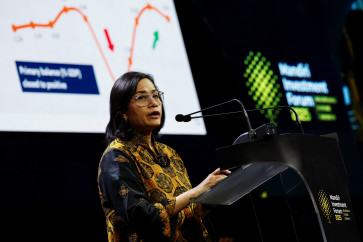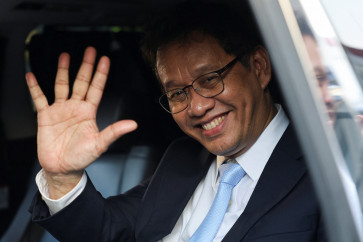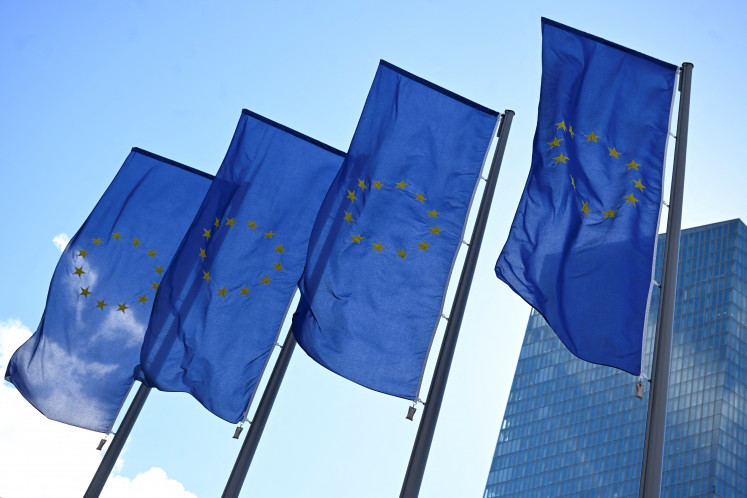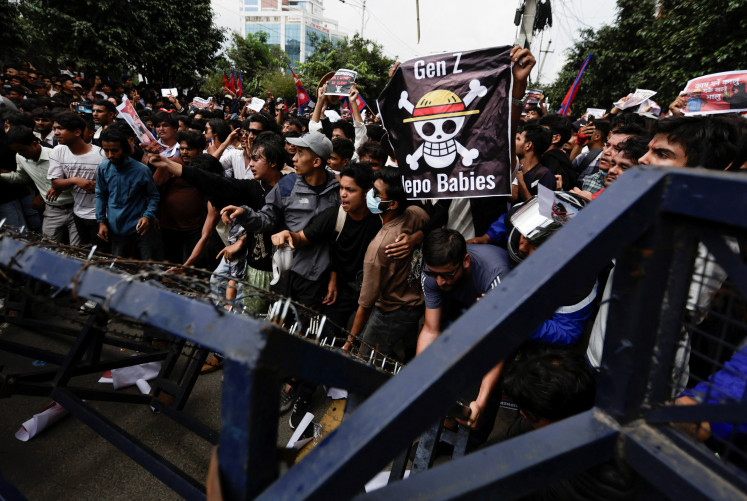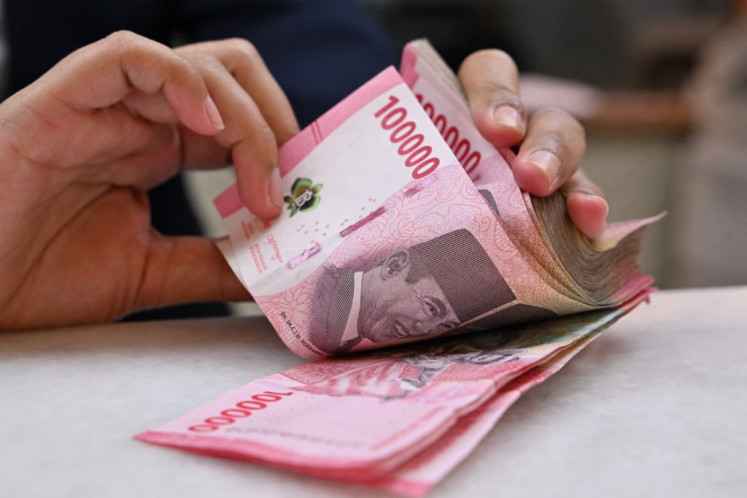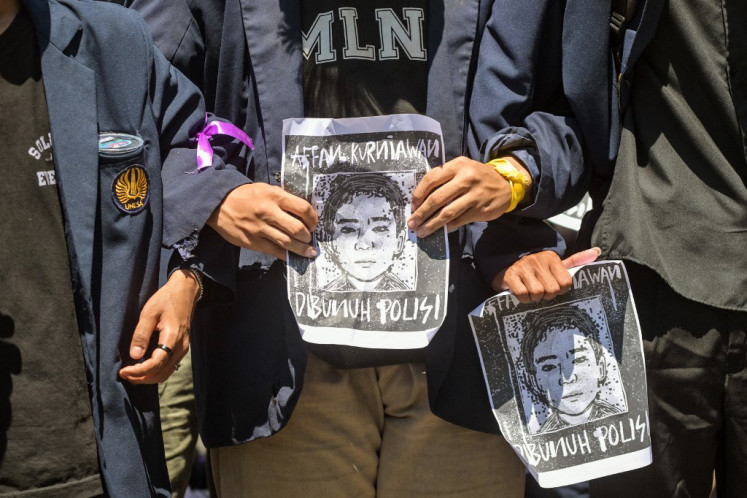Popular Reads
Top Results
Can't find what you're looking for?
View all search resultsPopular Reads
Top Results
Can't find what you're looking for?
View all search resultsHashtags hurt, hashtags heal too
The arrests of activists, the influence of algorithms and the surge of public frustration reveal how social media is actively fueling Indonesia’s ongoing democratic reckoning.
Change text size
Gift Premium Articles
to Anyone
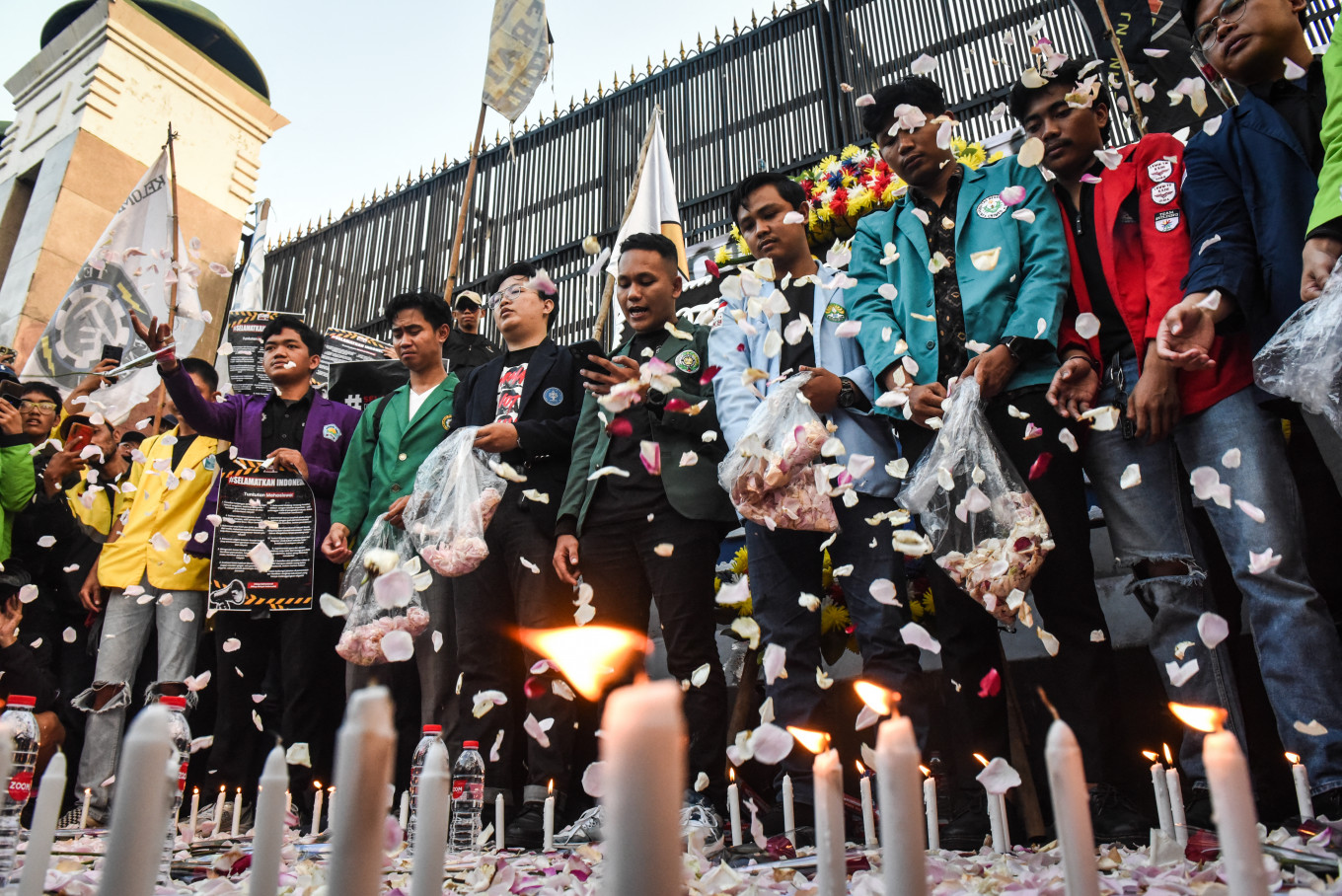 University students from the Indonesian Student Executive Board Alliance (SOBSI) scatter flower petals on Sept. 4 during a demonstration to reiterate the “17+8 People’s Demands”, a platform of short-term and long-term reform demands raised during recent protests in front of the House of Representatives complex in Central Jakarta. (AFP/Tyo Pribadi)
University students from the Indonesian Student Executive Board Alliance (SOBSI) scatter flower petals on Sept. 4 during a demonstration to reiterate the “17+8 People’s Demands”, a platform of short-term and long-term reform demands raised during recent protests in front of the House of Representatives complex in Central Jakarta. (AFP/Tyo Pribadi)
O
n the night of Sept. 1, the National Police forcibly detained Delpedro Marhaen, Executive Director of the Lokataru Foundation, a prominent human rights organization. Officers from the Jakarta Police arrived unannounced at the foundation’s office, citing vague charges of incitement and threatening Marhaen with up to five years in prison. No warrant was shown. No explanation was given.
The arrest followed Delpedro’s public criticism of police violence and his legal support for student demonstrators detained during protests on Aug. 28 that focused on housing compensation for legislators. Police alleged that Delpedro used social media to encourage students, including those underage, to participate in what they described as “anarchic actions.” According to Lokataru’s official statement, the arrest was not only unlawful, it was an attempt to silence dissent.
The country's August protests over low wages and politicians’ expenses escalated following the death of Affan Kurniawan, a 27-year-old online motorcycle transportation (ojol) driver who was fatally run over by a police armored vehicle during a demonstration in Jakarta. His death, captured on video and widely circulated online, ignited a wave of outrage that spread across platforms like TikTok, X (formerly Twitter) and Instagram.
In the middle of the protests, the digital public sphere was abruptly disrupted. TikTok, one of the country’s most widely used platforms, suspended its live streaming feature following the death of Kurniawan. While TikTok claimed the move was voluntary, government officials publicly blamed social media platforms for spreading “provocative content” and “endangering the public.”
The Communications and Digital Ministry denied ordering the ban, yet acknowledged reviewing TikTok’s policies and flagged “hate speech and incitement” as contributing factors to unrest. Civil society groups, including Amnesty International Indonesia, called the move censorship, warning that unilateral moderation undermines democratic expression.
This digital clampdown coincided with one of the most emotionally charged protest waves in recent Indonesian history. The Monash Data & Democracy Research Hub analyzed nearly 10 million online conversations and took samples of 13,780 original posts to understand the emotional, linguistic and political dynamics of the protests. The findings reveal a volatile mix of grief, anger and solidarity alongside a surprising swell of civic hope.
Hashtags such as #PolisiPembunuhRakyat (“Police Murder the People”) and #BubarkanDPR (“Disband the House”) surged within hours. The acronym ACAB (“All Cops Are Bastards”) and its numeric code 1312, imported from global protest cultures, were repurposed for an Indonesian context, appearing in memes, videos and protest flyers.
Hashtags became grief markers. They allowed people to express rage, mourn injustice and demand accountability in real time.
Indonesia is one of the world’s most active social media markets, with over 143 million users across platforms. For many, platforms like TikTok and Instagram are not just entertainment, they are political lifelines.
Digital anger evolved into digital hope. The emotional arc of the protests shows that people are not just reacting, they are reorganizing.
This shift was catalyzed by the emergence of the 17+8 Demands, a civic initiative led by youth influencers and civil society groups. The movement outlined 17 short-term demands and 8 long-term reforms, including audits of House spending, police accountability and political party reform.
Hashtags like #TuntutanWarga (“People's Demands”) and #WargaJagaWarga (“People Protect People”) gained traction, reframing the protests from rage to resolution. Engagement soared across platforms, with millions of views on TikTok and Instagram reels featuring protest guides, solidarity messages and legal advice.
But the government’s response has been mixed. While President Prabowo Subianto made a public statement and extended condolences to the victim, he also summoned Islamic organizations to “guard peace,” raising concerns about the politicization of religious groups. Meanwhile, police have blocked over 500 social media accounts and designated seven digital organizers as suspects.
Polarization is not inherently destructive, it can also be a glue that binds vulnerable groups together in pursuit of justice.
This dual role of polarization reflects findings from the Berkman Klein Center at Harvard University, which argues that digital polarization can foster both fragmentation and civic cohesion, depending on context and framing.
The protests also exposed Indonesia’s widening class divide. Viral posts condemned lawmakers for receiving 50 million Indonesian rupiah (US$3,000) monthly housing allowances, even as citizens faced rising costs and stagnant wages. Statements like House member Ahmad Sahroni’s insult, calling protesters “the dumbest people on Earth”, fueled further outrage.
People are not just angry at policies, they are angry at symbols. Luxury cars, designer watches and tone-deaf comments have become flashpoints for class resentment.
This sentiment aligns with broader research on political legitimacy. A 2024 study by the Institute for Policy Analysis of Conflict (IPAC) noted that “elite impunity and conspicuous consumption are increasingly viewed as moral violations, not just economic disparities.”
President Prabowo has supported the suspension of several House members and review allowances. But critics say these are symbolic gestures.
We recommend four key steps towards restoring trust in the government: acknowledge the existence and legitimacy of public grievances, respond with transparency and reform in the legislative branch, avoid glorifying elite lifestyles and create safe channels for citizen participation in voicing their aspirations regarding government policies.
The government must listen, not just to the noise, but to the meaning behind it.
The protests may mark a turning point in Indonesia’s democratic trajectory. While previous demonstrations focused on specific policies, this movement reflects a broader demand for systemic change. From diagnostic framing (“who’s to blame”) to prognostic framing (“what can be done”), the digital public is evolving into a civic force.
Social media played a central role, not just as a communication tool, but as protest infrastructure. Platforms like X, Instagram and YouTube became arenas for emotional expression, narrative framing and real-time mobilization. Posts with high engagement included a statement by President Prabowo viewed 19.7 million times, and a tribute to Affan Kurniawan by Tempo.co, which reached 3 million users. International media coverage such as by Al Jazeera, India Today, CNN, BBC and ABC Australia reached even more eyes to understand the situation in Indonesia.
As the 17+8 Demands gain momentum, the question remains: will Indonesia embrace digital civic expression or suppress it? For now, the streets may go quiet, but the algorithms of discontent continue to pulse, louder, sharper and more determined than ever.
---
Ika Idris and Derry Wijaya are associate professors at the Public Policy & Management program, Monash University Indonesia and co-directors of Monash Data & Democracy Research Hub. Musa Izzanardi, Lucky Susanto, Idhamsyah Eka Putra, Nala Edwin Widjaja, Febi Amalinda, Nurul Amalia contributed to this op-ed. The article is republished under a Creative Commons license.


